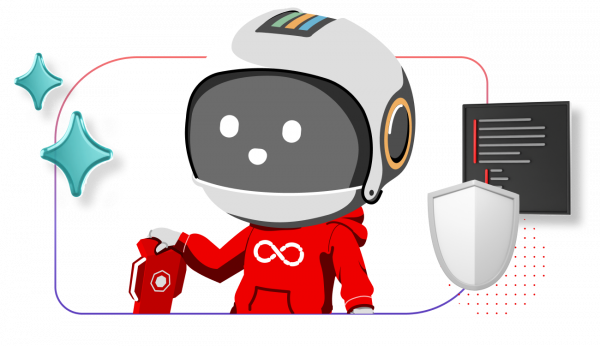Red Hat Developer's mascot Repo is turning one! It's hard to believe a full year has passed since this helpful, code-slinging bot crash-landed onto the scene. To celebrate Repo's first birthday, we're looking back at the key moments that defined an eventful year for Red Hat Developer and the open source community.
October 2024: A star is born
We officially welcomed Repo, a curious "reponaut" who was created during a hybrid cloud convergence event. Repo's mission is to help developers fix complex coding issues (or "data rifts") by storing code and dimension-shifting into the Developer Sandbox, a digital realm of raw computing energy.

November 2024: Spotlight on developer productivity and app performance
Last year’s KubeCon + CloudNativeCon North America demonstrated Red Hat's focus on efficient developer experience. Key announcements included new capabilities in Red Hat OpenShift AI to help teams scale and manage complex AI workloads across the hybrid cloud, alongside a stability-focused release of Red Hat OpenShift 4.17. The event also showcased new software templates in Red Hat Developer Hub, which speed up the process of building and deploying AI-enabled applications.
Meanwhile, the open source Quarkus project surpassed the 1,000 contributor milestone, validating its mission to modernize enterprise Java. This community growth reflected the demand for a Kubernetes-native framework that offers improved startup times and reduced memory consumption compared to traditional Java platforms.
January–April 2025: Preparing for the AI era
In January, Red Hat completed its acquisition of Neural Magic, paving the way for key announcements later in the year.
Meanwhile, our top-read articles converged around two themes: modernizing cloud infrastructure and improving core productivity. Interest in cloud infrastructure centered on GitOps and Red Hat OpenShift Virtualization. For productivity, developers explored new features and improvements in compilers like GCC 15. The popularity of posts about large language models (LLMs) confirmed that AI is a central focus for developers; topics included improving vLLM performance and Day 0 inference support for new models like Llama 4.
May 2025: Repo goes to Red Hat Summit
Ever wonder what an open source reponaut does at a tech conference? Watch the video to see Repo’s adventures with Red Hat's Dan Russo at Red Hat Summit and AnsibleFest 2025.
Key event announcements included:
- Red Hat Enterprise Linux 10: This major release is an AI-driven, quantum-ready platform that features NIST compliance for post-quantum cryptography and introduces the RHEL image mode for immutable OS deployments. Red Hat also announced a collaboration with SiFive for a RISC-V Developer Preview for RHEL 10, significantly broadening hardware architecture support.
- Red Hat AI Inference Server: A new containerized offering that provides a hardened, supported distribution of vLLM and other technologies to optimize and accelerate Gen AI model inference across any hybrid cloud.
- llm-d: A new open source project focused on distributed AI inference methods to enable greater scalability and performance for LLMs running on Kubernetes.
- Red Hat OpenShift Lightspeed (general availability): A generative AI virtual assistant integrated into the OpenShift console to simplify platform tasks by providing context-aware guidance and configuration assistance to both developers and administrators.
- Red Hat Advanced Developer Suite: A comprehensive new collection of tools and runtimes aimed at accelerating cloud-native application development, providing an integrated experience across the development lifecycle.
June–July 2025: Enhancing developer tools and subscriptions
Red Hat OpenShift 4.19, released in June 2025, focused on unifying and improving the developer experience by merging the Admin and Developer perspectives into a single default console view. The release brought several key toolchain improvements, including updates to Red Hat OpenShift Dev Spaces and Red Hat OpenShift Pipelines, while making the generative AI assistant Red Hat OpenShift Lightspeed generally available to all users.
We also announced Red Hat Enterprise Linux for Business Developers, which provides no-cost, self-service access to the enterprise Linux platform for corporate development and testing, allowing teams to provision up to 25 instances per user. Developers can build and test applications on the identical, production-approved OS, complete with enterprise container tools and content. This new offering empowers business developers to accelerate application delivery while ensuring consistency with IT operations.
October 2025: Ansible 2.6 goes GA
Ansible Automation Platform 2.6 introduces powerful features focused on accessibility and intelligence, including the generally available self-service automation portal and the on-premise automation dashboard for metric tracking. The release also adds the Ansible Lightspeed intelligent assistant for platform administrators and a technology preview of Ansible development workspaces for consistent content creation.
What’s next for the developer community?
Repo’s first year was packed with innovation, from simplifying AI model optimization and adoption to delivering more efficient cloud infrastructure via GitOps and OpenShift Virtualization. The speed of development and the depth of our open source collaboration is increasing, and we’re looking forward to what the next year will bring.
Thank you for being an essential part of the Red Hat Developer community. Don't forget to wish Repo a happy birthday on social media! Find us on LinkedIn and X.
